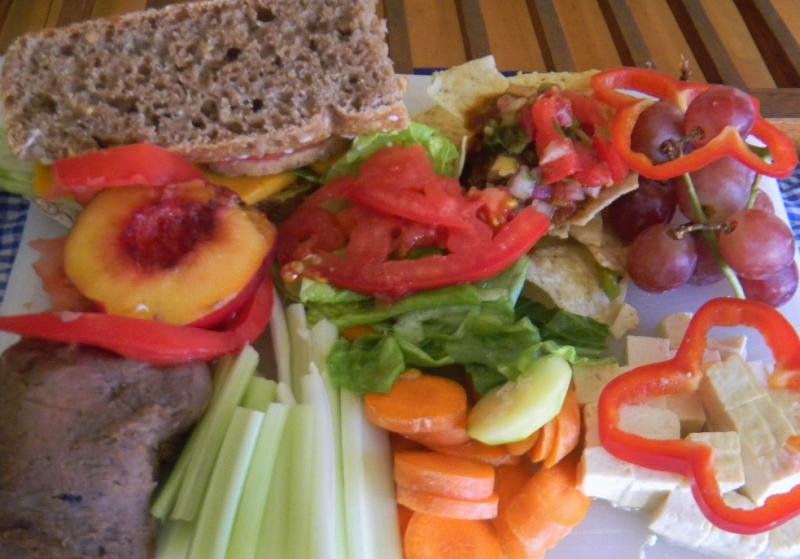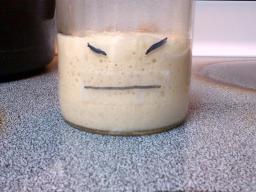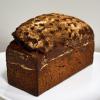We have wanted to take up Michael Wilson’s ‘Spelt Challenge’ of 100% white spelt at 100% hydration ever since we saw his fine post. In our case we milled the whole grain and sifted it to 78% extraction.


We like whole grain breads and hate to throw the sifted out portion away. Michael suggested that we could put it back in on the last set of slap and folds to try to minimize gluten strand harm. So that is what we did and we also added 40g (dry weight) of spelt sprouted berries while we were at it since we love sprouts as much as whole grains.


Even though this isn’t an equal challenge since our whole grains would be more thirsty and thus the dough easier to work with, it was still a sloppy mess but oddly not that difficult to work with like rye would have been.


The bad part of the process is that our 15 year old Krupp’s coffee grinder that we have used to grind grain gave up the ghost. We usually watch how hot it gets and how much grain we put in it at one time but my apprentice ignored both on the last grind for this bread. Right as we were about to say done – it was.


The bread came out as flat boule as the last 100% hydration bakes seem to end up. These breads really should be baked as a ciabatta or in a loaf tin rather than deflating them when transferring from the basket to the hot DO. But we thought we would give it one more try to get it to spring in the oven.

The bread baked up a nice shade of brown but not the dark color we usually prefer - higher oven temps and less time covered might give us a better crust. It did blister a little though. The crumb was much more open than we thought it would be as was the pervious kamut flat boule and it was soft and very moist. This bread is even more delicious than the kamut was and is its best quality. It is a fine bread for sandwiches or even dirtlocks. We like this bread a lot even though it too took the flat boule route as the kamut did before it.


Method
If you make this bread you want to start the sprouts 2 days before you need them because unlike rye which sprouts in 24 hours these take 48. Just soak them in water for 3 hours, drain them and spread them our between damp paper towels and cover with plastic wrap so they don’t dry out. Finally cover them in a kitchen towel so no light gets to them. Re-dampen the top paper towels at the 24 hour mark and 24 hours later you will have perfect spelt sprouts.


The spelt levain was developed over two, (3) hour builds from our kamut starter and then refrigerated for 24 hours. It was then removed from the fridge and allowed to further develop on the counter for 2 hours.
The 78% extraction flour and the extraction were autolysed separately for 2 hours. The salt, VWG and malts were autolysed with the 78% extraction. We wanted the VWG to make sure we had some gluten in the final mix and was very glad it was there.

The water was a combination of Shiitake mushroom re-hydration water, spelt soaker water and RO water. Since the water equals the flour weights it was split up between the two autolyses based on weight of the flour and the bran.

The dough flour autolyse and the levain were combined in the KA mixing bowl and mixed on KA 2 with the paddle for 4 minutes. The dough hook was then used and the dough was kneaded for 10 more minutes. The dough was then placed in an oiled, plastic covered bowl for 10 minutes.

2 sets of stretch and folds were done 10 minutes apart with each set being 25 stretches. Then 3 sets of French slap and folds were done for 10 minutes duration each and 10 minutes apart with the dough being rested in the plastic covered bowl between sets. At the beginning of the last set of slap and folds, the bran autolyse was incorporate. Half way through the last set, the sprouts were incorporated. The final 5 minutes of slap and folds fully incorporated the bran and sprouts.


We were really surprised that the slap and folds were so easy. A light oiling of the granite countertop was all that was needed to keep it from sticking. After 20 minutes of slap and folds the dough was very extensible and the dough would hold a ball shape for the shortest period of time but you could tell the gluten was starting to come together.

a Lunch grilled chicken sandwich and fixin's with tofu, re-fried beans, red pepper, carrots, celery sticks, salad with tomato, half a peach, red grapes with corn tortilla chips, Brownman's Red Salsa and Pico de Gillo. Red breakfast with apple butter and caramelized minneola marmalade, strawberry, watermelon and red grapes.

Once the sprouts and bran were worked in, the dough behaved better but still would not hold a ball shape for more than a few seconds. The slap and folds really weren’t difficult or the exhausting chore we thought they would be in the end. It was really kind of fun to do them once you got in the rhythm.

Last night's sunset was something to behold.
A cloth lined basket was heavily floured with rice flour and used to house the nearly un-shapeable dough as a semi, sort of ball. It was immediately housed in a trash can liner and placed into the fridge for a 12 hour retard and proof.
We think that this dough should be proofed in a loaf pan but since we planned on baking it in a hot DO we needed a transfer agent and the cloth lined basket was the needed transfer vehicle. We hoped that the cold would help give the dough some additional structure to make the transfer a success. We won’t try to slash this dough since it is so wet and figure it will spread in the DO.
The Big Oven was fired up to 500 F with the DO inside. The dough transfer went as well as expected but it did stick to the cloth liner somewhat – no worries – and it did spread faster than peanut butter sitting in a DO on a hot fire in the hot AZ sun.
We turned the oven down to 450 F after 10 minutes and baked it for 22 minutes with the lid on. We then turned the oven down to 415 F (convection this time) and baked it for 10 more minutes, turning it 180 degrees after 5, with the lid off before taking the bread out of the DO and testing for temperature.
The middle was 209 F so we turned off the oven and left the bread on the stone to crisp the skin for 10 minutes with the door ajar. The bread was then moved to the cooling rack and then onto. Total baking time was 32 minutes not including the rest on the stone at the end. The formula brings up the rear as usual.
100 % Hydration, 100% Whole Spelt Sourdough | | | | |
| | | | |
Starter Build | Build 1 | Build 2 | Total | % |
Spelt Starter | 20 | 0 | 20 | 3.46% |
Whole Spelt | 40 | 40 | 80 | 13.84% |
Water | 40 | 40 | 80 | 13.84% |
Total | 100 | 80 | 180 | 31.14% |
| | | | |
Spelt Starter | | % | | |
Whole Spelt | 90 | 15.57% | | |
Water | 90 | 15.57% | | |
Starter Hydration | 100.00% | | | |
Levain % of Total | | 14.37% | | |
| | | | |
Dough Flour | | % | | |
Whole Spelt | 488 | 84.43% | | |
Total Dough Flour | 488 | 84.43% | | |
Salt | 9 | 1.56% | | |
Water 330, Mush R 120, Soak 62 | 512 | 88.58% | | |
Dough Hydration | 104.92% | | | |
| | | | |
Add - Ins | | % | | |
Red Rye Malt | 2 | 0.35% | | |
White Rye Malt | 2 | 0.35% | | |
VW Gluten | 20 | 3.46% | | |
Spelt Sprouts | 40 | 6.92% | | |
Total | 64 | 11.07% | | |
| | | | |
Total Flour w/ Starter | 578 | | | |
Total Water w/ Starter | 602 | | | |
Tot. Hydration w/ Starter | 104.15% | | | |
Hydration w/ Adds | 100.00% | | | |
Total Weight | 1,253 | | | |
% Whole Grain | 100.00% | | | |





